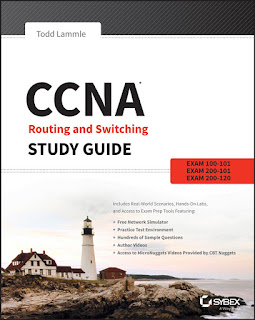CCNA Routing and Switching Study Guide
CCNA Routing and Switching Study Guide
Internetworking
The following ICND1 exam topics
are covered in this chapter :
11 Operation of IP Data Networks
■■ Recognize the purpose and functions of various network
devices such as Routers, Switches, Bridges and Hubs.
■■ Select the components required to meet a given network
specification.
■■ Identify common applications and their impact on the
network.
■■ Describe the purpose and basic operation of the protocols in
the OSI and TCP/IP models.
Welcome to the exciting world of internetworking. This first
chapter will serve as an internetworking review by focusing
on how to connect networks together using Cisco routers and
switches, and I’ve written it with the assumption that you have some simple basic networking
knowledge. The emphasis of this review will be on the Cisco CCENT and/or CCNA
Routing and Switching (CCNA R/S) objectives you’ll need a solid grasp on in order to succeed
in getting your certifications.
Let’s start by defining exactly what an internetwork is: You create an internetwork when
you connect two or more networks via a router and configure a logical network addressing
scheme with a protocol such as IP or IPv6.
We’ll also dissect the Open Systems Interconnection (OSI) model, and I’ll describe
each part of it to you in detail because you really need complete, reliable knowledge of it.
Understanding the OSI model is key for the solid foundation you’ll need to build upon with
the more advanced Cisco networking knowledge gained as you become increasingly skilled.
The OSI model has seven hierarchical layers that were developed to enable different
networks to communicate reliably between disparate systems. Since this book is centering
upon all things CCNA, it’s crucial for you to understand the OSI model as Cisco sees it, so
that’s how I’ll be presenting the seven layers to you.
After you finish reading this chapter, you’ll encounter review questions and written labs.
These are given to you to really lock the information from this chapter into your memory.
So don’t skip them!
To find up-to-the-minute updates for this chapter, please see
www.lammle.com/forum or the book’s web page at www.sybex.com.
Internetworking Basics
Before exploring internetworking models and the OSI model’s specifications, you need to
grasp the big picture and the answer to this burning question: Why is it so important to learn
Cisco internetworking anyway?
Networks and networking have grown exponentially over the past 20 years, and understandably
so. They’ve had to evolve at light speed just to keep up with huge increases in
basic, mission-critical user needs, (e.g. simple sharing data and printers), as well as greater
burdens like multimedia remote presentations and conferencing. Unless everyone who needs













No comments:
Post a Comment